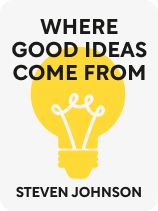

This article is an excerpt from the Shortform book guide to "Where Good Ideas Come From" by Steven Johnson. Shortform has the world's best summaries and analyses of books you should be reading.
Like this article? Sign up for a free trial here.
Do you have a million ideas in your head that seem to go nowhere? Are you looking for fresh ideas to solve specific problems?
Steven Johnson takes us on an exciting exploration of good ideas and novel innovations. For an idea to be good, he says, it must be built upon accumulated knowledge and be put forward at a time when users can conceive of how to use the idea and when the needed resources for the idea are available.
Keep reading to learn how to develop ideas and, ultimately, advance knowledge and society.
How to Develop Ideas
In Where Good Ideas Come From, Johnson discusses how to develop ideas and turn them into innovations. According to Johnson, good ideas don’t just emerge miraculously from nothing. Instead, they build on existing knowledge and ideas. If every writer had to create their own writing system, or if every app developer had to reinvent the internet, we wouldn’t be able to progress as a society and would be stuck with only the most basic ideas. The more we innovate and create, the more we draw on established knowledge to innovate further, enabling us to come up with increasingly advanced ideas.
(Shortform note: In The 5 Elements of Effective Thinking, Edward Burger and Michael Starbird expand on this idea and suggest that studying how an idea has developed over time can help you come up with new ideas. Doing this gives you a better understanding of the idea’s underlying concepts and also leads you to consider innovations for an idea even after it seems to be completed.)
Previous ideas provide platforms of knowledge on which to build. Platforms can be physical—such as a piece of technology like a steam engine or a computer—or conceptual—such as the ideas and knowledge that allowed us to create such technologies. Platforms not only prop up new ideas, but they also provide parameters, or, in the case of the arts, genres. It’s necessary to understand these parameters in order to bend or break them, which allows for greater insight and innovation.
For example, someone writing a book uses a number of different platforms that developed over millennia: the language they’re writing in, the tool they’re using to write (such as a computer or pen and paper), and any previously written works that are informing their current work. That writer may then choose to take parameters from various genres—such as children’s literature, romance, and coming-of-age stories—to create a new genre like young adult literature.
(Shortform note: Consumer needs can also act as a platform for new ideas. Noticing something that consumers need—even if the consumers don’t know they need it—can provide parameters for the development of a new idea, such as its desired function and the context in which it will be used. Experts recommend using empathic design to identify what a consumer needs, which involves observing someone as they use a current product and noticing what could be made easier or better. They suggest that observation works better than methods like surveys because consumers often develop workarounds for design insufficiencies without even noticing.)
Combining or shifting across platforms of knowledge can open up further opportunities for discovery. Johnson gives the example of how scientists figured out Darwin’s Paradox. This paradox was Charles Darwin’s observation that a massive biological system like a coral reef could exist in an ecosystem with very little nutrition and resources. The question of how such a system could exist was solved when scientists from multiple fields, including biology, chemistry, systems, and more, combined their knowledge to discover that a number of different biological platforms work together to recycle resources and nutrients that keep the system alive. This combination of sciences led to a new field called ecosystems ecology.
(Shortform note: Combining platforms in the way Johnson describes is a type of transdisciplinary thinking. This is an extension of multidisciplinarity and interdisciplinarity. Multidisciplinarity refers to approaching a single topic from a variety of perspectives, each of which adds its own distinct understanding or analysis to the topic. Interdisciplinarity also involves multiple perspectives, but instead of viewing them separately, they’re treated as interrelated. Transdisciplinarity connects the disciplines even further, breaking down the boundaries between them to form a cohesive whole—such as a new field of science or a new genre of media.)
Johnson points out two other hallmarks of the most successful ideas: They proliferate in networks and emerge in the “adjacent possible.” We’ll look at both hallmarks next.
Developing Ideas That Are Within Reach
Platforms of knowledge also shape the realm of the adjacent possible. The adjacent possible is a theory developed by Stuart Kauffman that refers to the realm of new ideas that are within reach based on society’s current available information, resources, and abilities. While good ideas can come from outside the adjacent possible, all successfully implemented ideas come from within it.
The idea of the adjacent possible helps explain the phenomenon of “the multiple.” This is a historical trend in which the same novel idea is discovered by multiple people working independently of each other. If different people are working from the same knowledge base, then the realm of possibilities for their work will be similar, even if they aren’t working together, because they’re all limited to the base knowledge’s adjacent possible.
Networking to Create Better Ideas
According to Johnson, having networks of ideas that build and connect with each other is also essential to coming up with good ideas. Networks can take many different forms, including physical communities, online spaces, or anything that facilitates collaboration between people. They can even include the networks that comprise our own brains. Johnson suggests that, the more people who are involved in a network, the more effective they’ll be at spawning and promoting ideas.
One of the most important networks Johnson discusses is the city. Cities represent a great confluence of different thoughts and perspectives, and importantly, the storing and recording of ideas through common knowledge or written language.
In recent years, the internet has proven to be an effective tool for networking ideas, as well. The internet provides immediate access to vast amounts of information and, unlike city networking, it can be accessed no matter where you are geographically.
We rely on networks between people, but we also rely on networks within our brains. These connections and their ability to change and form new patterns—an ability known as plasticity—are the key to the mind’s ability to learn and grow.
Exercise: Find Your Own Great Idea
Johnson both explains the process of developing ideas and offers many ways to help you create them. Use these concepts to come up with a great idea of your own.
- First, identify a problem you want to solve or a hunch you have. What is something you know could be better, even if you don’t yet know how? Does your favorite video game have a frustrating game mechanic? Or have you noticed a flaw in your company’s organizational structure?
- Next, consider what networks you could tap into to help solve this problem. Who is affected by it? In what ways could you consult with or collaborate with them?
- Finally, try to cultivate an insight to help you move forward with your idea. What are some techniques you could use to elicit an epiphany? Consider taking a walk, spending some time immersing yourself in the information underlying your idea, or using technology like a search engine or AI to give your ideas a boost.

———End of Preview———
Like what you just read? Read the rest of the world's best book summary and analysis of Steven Johnson's "Where Good Ideas Come From" at Shortform.
Here's what you'll find in our full Where Good Ideas Come From summary:
- How the world's best inventions grow from minor inklings
- How capitalism negatively impacts innovation
- Why making mistakes is essential to great innovations






